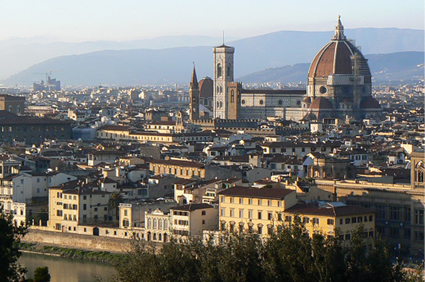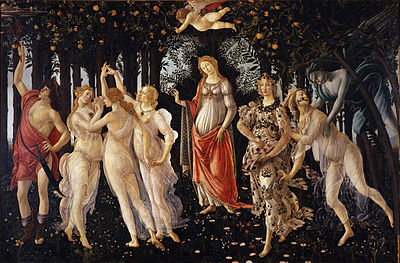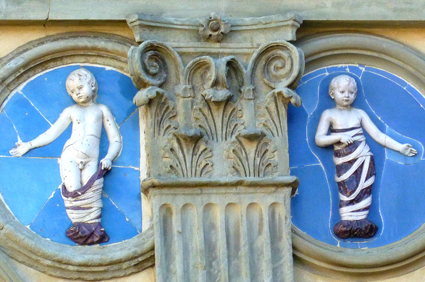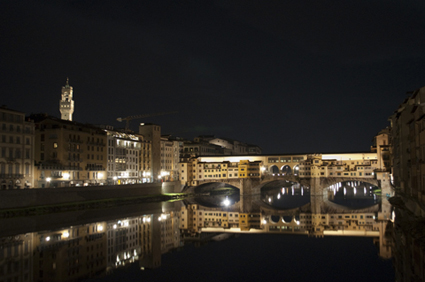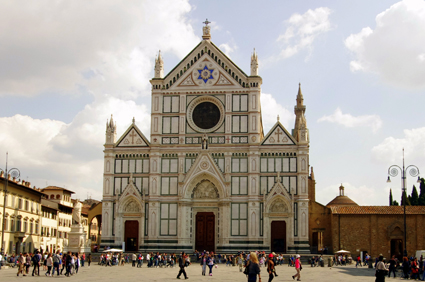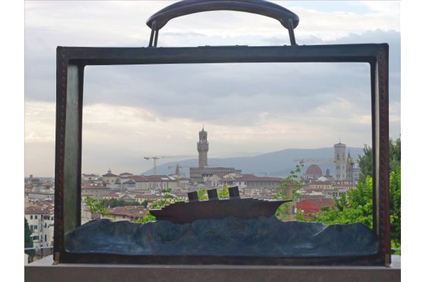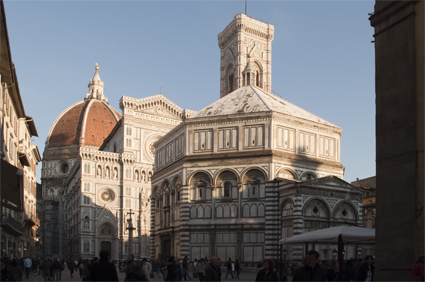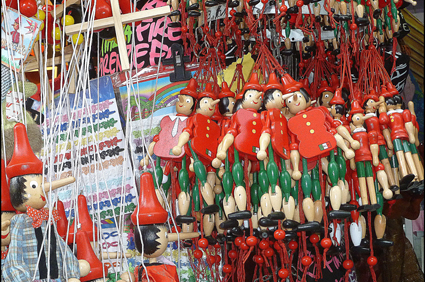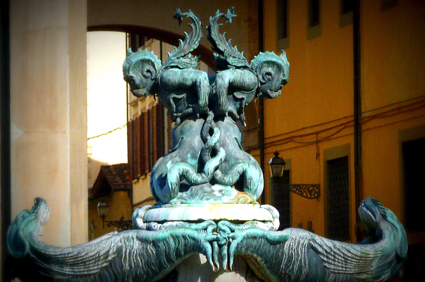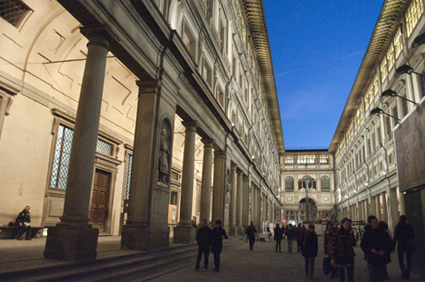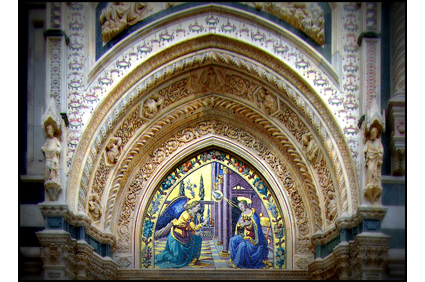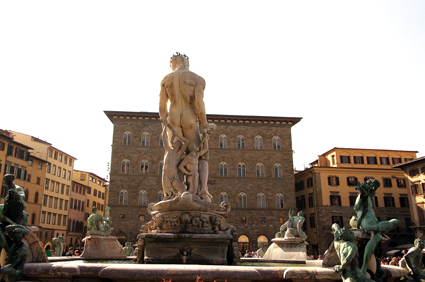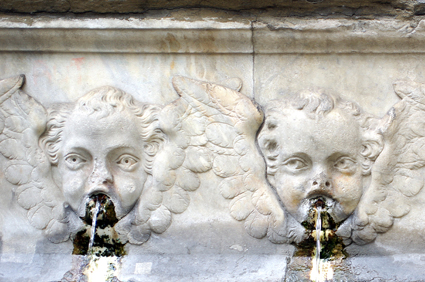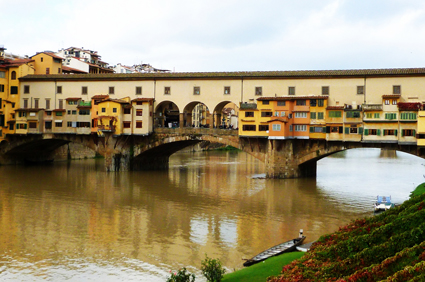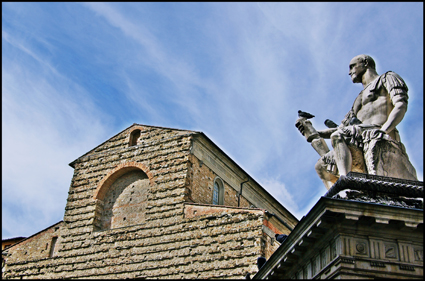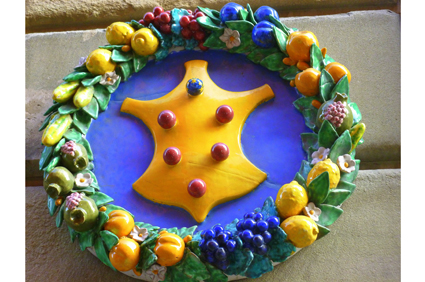Florence is an open air museum and no other Italian city has so many masterpieces, crammed into such a small area.
An official, licensed guide can help you discover much more, without running the risk of being overexposed to too much in too short a time - you can enjoy a walking tour and hear stories and legends, highlights and details relating to an outstanding city, where religious art contains fascinating allusions to civic and political concepts. You will discover why Florence is called the cradle of the Renaissance.
An introduction to Florence itinerary is a "must", for those who come to Florence for the first time.
We start at the Gallery of the Academy, where there are seven famous sculptures by Michelangelo, among them the unfinished sculptures called the Prisoners and, of course, his first superb David, an icon of Western art.
The Basilica of Santa Croce is the next item on our itinerary. Besides being an important religious building, it houses the tombs of famous Italians, such as: Michelangelo, Florence's most famous and beloved artist, Galileo Galilei, who was protected by the Medici family and Machiavelli, father of political science.
More...An English speaking driver will pick you up from your ship and drive you back to your ship's embarkation pier in Leghorn (Livorno) after your tour.
The Round-Trip Livorno-Florence-Livorno service also includes a stop in Florence at Piazzale Michelangelo, where you can admire the most stunning panoramic view of the town.
Fees and Tours
These are some options of our tours
Small Groups (1 - 12 persons):
- Clasical Florence plus Academy - 3hours - 150 euros
- Clasical Florence plus Academy plus Holly Cross Church - 4 hours -200 euros
- Clasical Florence plus Academy plus the Medici Chapels - 4 hours -200 euros
- Clasical Florence plus Uffizi - 5 hours - 250 euros
- Clasical Florence plus Academy plus Uffizi - 6 hours - 300 euros
- Uffizi plus Academy - 5 hours- 250 euros
€ 50 each aditional hour
A 6 hours tour can be divided in 2 days.
Special fees for small families (2 adults and kids):
- 3 hours - 135 euros
- 4 hours - 180 euros
- 5 hours - 225 euros
- 6 hours - 270 euros
Fees for groups from 12 up to 30 persons:
- Half-day (max 3 hours) € 130 + € 2 for each extra person more
- Full-day (max 6 hours) € 260 + € 4 for each extra person more
P. IVA 04910610486
An introduction to Florence itinerary is a "must", for those who come to Florence for the first time.
We start at the Gallery of the Academy, where there are seven famous sculptures by Michelangelo, among them the unfinished sculptures called the Prisoners and, of course, his first superb David, an icon of Western art.
Reaching the Cathedral Square, the religious heart of Florence we shall stroll around the piazza to see the Cathedral, also known as the Duomo, with its outstanding dome by Brunelleschi, Giotto's Bell Tower and the Baptistery with its splendid Paradise Doors.
We shall wander through the medieval alleys where Dante Alighieri, author of the Divine Comedy, lived and pop into the tiny church where he usually attended Mass, before he was exiled from Florence.
When we reach the Signoria Square, the political heart of the city, we enter a kind of open air museum! The wonderful statues have been there for almost 500 years!
The austere bulk of Palazzo della Signoria (also called Palazzo Vecchio - old palace - after the Medici family defeated the Florentine Republic in1530) with its fortress - like architecture is imposing and severe. It was built as the administrative headquarters of the Medieval Republic of Florence and is still the seat of the Town Council. Inside, the rooms are decorated with murals or frescoes which illustrate the history of Florence and the deeds of the Medici family, who commissioned them.
Not far from the Signoria Square, we can admire the Ponte Vecchio, the oldest bridge built across the river Arno. It owes its fame not only to its antiquity but also to the dazzling array of jewellery shops, which have been there since the late 1500's.
We shall walk on to Repubblica Square, formerly the meeting point of the two main Roman roads of the town, which crossed where the statue of Flora stands atop the column, where the Roman Forum was and which became the Market Square during the Middle Ages. The 19th century buildings surrounding the square replace the oldest buildings in Florence, which had been converted, in the 16th century, into a Jewish ghetto by the Medici. To erase the memory of this injustice, the Florentines converted the oldest part of the town into a stylish and busy piazza, where Florentines meet for an espresso and window shopping.
The Orsanmichele Church, formerly a granary and grain market, was converted into a church after the terrible Bubonic Plague epidemic of 1348. The 14 sculptures in the niches outside, made by some of the most famous sculptors of the 15th Cent., represent the patron saints of the Florentine trade guilds.
Just nearby, is the New Market- also called Mercato del Porcellino (piglet) due to the bronze sculpture of a wild boar. Rubbing its nose is a Florentine tradition... said to bring good luck.
Just a short walk away, the Uffizi Gallery houses one of the most important collections of paintings by Italian artists.The paintings are displayed chronologically, progressing through Italian Christian art from Giotto to Caravaggio, including Botticelli's Birth of Venus and Spring; icons of the Renaissance, continuing with paintings by Michelangelo, Leonardo, Raphael and Titian.
The Basilica of Santa Croce is the next item on our itinerary. Besides being an important religious building, it houses the tombs of famous Italians, such as: Michelangelo, Florence's most famous and beloved artist, Galileo Galilei, who was protected by the Medici family and Machiavelli, father of political science.
The Italian poet Ugo Foscolo, also buried in the basilica, called it the Pantheon of the great Italians!
San Lorenzo complex: surrounded by a colourful market, it includes the Basilica built by Brunelleschi. No other church is such a perfect instance of Renaissance architecture: pure, elegant, harmonious elegance... a revival of classical art. It's also possible to visit the marvellous Laurentian Library, designed by Michelangelo to house the hundreds of volumes and manuscripts owned by the Medici family. Some of them are on display. This splendid library is considered a unique jewel of architecture. The Medici Chapels include the New Vestry, designed by a youthful Michelangelo - one of his first architectural projects - which encloses seven statues by him, decorating three tombs. Four of the statues powerfully embody Dusk, Dawn, Day and Night. The Medici Mausoleum - the Princes' Chapel by Nigetti and Giovanni de'Medici is also part of the San Lorenzo complex. Almost all the grand-ducal members of this family are buried in the floor of the under-croft. The upper level walls are covered with marble and semi precious stones.
The Medici-Riccardi Palace: the first residence of the Medici family. The massive building, all in stone, built by Michelozzo, the architect of the first of all Florentine palaces to be built in the Etruscan or Repubblican style: palazzo Medici was commissioned by Cosimo the Elder the founder of many of the branches of the Medici bank. It became the prototype for other palaces owned by the rich families during the Early Renaissance. Inside, one can visit the chapel with its walls covered by Benozzo Gozzoli's magnificent frescos describing the journey of the Magi to Bethlehem. The portraits of the Medici family members figure largely in the scenes.
Crossing the Arno river, via the Ponte Vecchio, one comes to the Pitti Palace: this imposing palace was the Grand-ducal Medici residence for two centuries. When the family died out in the 1700's, the palace became the residence of the Lorraine family and later of the Savoy royal family of Italy. Behind the Pitti Palace one can admire the Boboli Gardens: one of the most important examples of an Italian garden of the 1500's and, on the first floor, the Palatine Gallery, with Pietro da Cortona's and Ciro Ferri's dazzling stuccoes and frescoes that decorate the private painting gallery of the Medici grand-dukes with its fabulous masterpieces, arranged as they were first hung in the 1640s, including 13 paintings by Raphael.
Piazzale Michelangelo, an esplanade, placed on the hill overlooking Florence from the South, offers the best view of the city. Nearby is the magnificent church of San Miniato al Monte, one of the most fascinating and beautiful of the Florentine churches: it is built around and on top of a Roman Mithras temple and contains exquisite mosaics and frescoes, as well as enjoying a spectacular view over the city.
An English speaking driver will pick you up from your ship and drive you back to your ship's embarkation pier in Leghorn (Livorno) after your tour.
The Round-Trip Livorno-Florence-Livorno service also includes a stop in Florence at Piazzale Michelangelo, where you can admire the most stunning panoramic view of the town.
The driver will drop you off in the historic centre of Florence, where you will meet your guide to start a walking tour. The driver will be at the same spot again to take you back to the port of Livorno at the conclusion of the tour.
This service is for maximum 8 people.
Fee including round trip transportation and tourist guide service: 590 euros.
For 60 euros extra you can make a short stop at Pisa to see the famous leaning tower.

